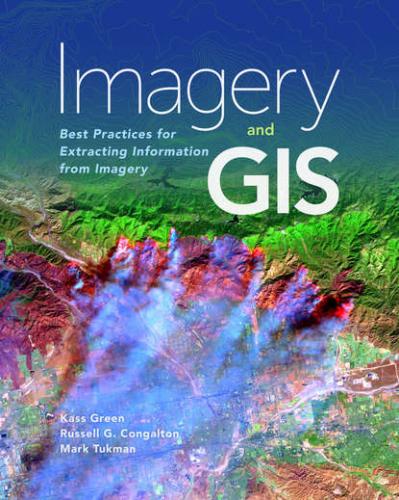Book Organization
The organization of the book follows the organization of a typical imagery project workflow and is broken into four sections. The first section, Discovering Imagery—four chapters—provides the information needed to choose the best imagery to meet your needs. Chapter 2 introduces the structure of imagery data and presents a construct for thinking about imagery that is the foundation of this book, and also provides a decision framework for all of your work with imagery. Chapter 3 examines the fundamental collection and organizational characteristics of imagery that determine what imagery dataset will bring the most value to your projects. Chapter 4 provides a framework for choosing the best imagery to meet your needs and describes the variety of imagery datasets available.
The second section, Using Imagery in a GIS—two chapters—focuses on how to manipulate imagery to increase its value within a GIS. Chapter 5 discusses imagery storage and formats, displays, mosaicking, and accessing imagery as web services. Chapter 6 reviews the methods used to control unwanted variation in imagery caused by the earth’s atmosphere and terrain.
The third section, Extracting Information From Imagery—five chapters—details how to efficiently and accurately extract information from imagery. Chapter 7 introduces the importance of developing a robust classification scheme to characterize variation on the ground. Chapter 8 reviews how digital elevation models are created from imagery. Chapter 9 introduces imagery elements and discusses a variety of techniques and tools for exploring the correlation between imagery variation and variation on the ground. Chapter 10 reviews image classification approaches ranging from manual interpretation to sophisticated semi-automated classification. Chapter 11 discusses the concepts and methods commonly employed for using imagery to monitor change.
The fourth section, Managing Imagery and GIS Data—three chapters—focuses on ensuring the effective management and use of imagery and maps created from imagery. Chapter 12 introduces concepts and techniques for assessing the positional and thematic accuracy of imagery products and services. Chapter 13 reviews using ArcGIS to publish and serve imagery, imagery products, and imagery services. The book’s concluding chapter lists experience-proven tips for successfully deriving the most value from imagery.
This book is illustrated with over 150 figures which clarify many of concepts presented. Over 30 of these figures are linked to interactive applications, which allow you to explore the concepts in more depth. If a figure is linked to an application, you will see a blue Esri url in the figure caption.
Case Study of Sonoma County, California
During the writing of this book, the authors also had the pleasure of creating a high-resolution vegetation type map of Sonoma County, California (approximately 1 million acres) for the Sonoma County Agricultural Preservation and Open Space District and its partners. A map of 85 vegetation types at a 1-acre minimum mapping unit (or smaller for some wetland and riparian features) was created using a variety of imagery and nonimagery sources including Landsat, National Agricultural Imagery Program (NAIP) imagery, hyperspectral imagery, digital elevation models, wildfire history, weather measurements, previously created vegetation maps, and NASA-funded six-inch multispectral imagery and lidar data1. Additionally, other GIS layers were created from the imagery including an impervious-surfaces map, a croplands map, building footprints, and many hydrologic data deliverables such as stream centerlines. The project products support decision making for natural resource planning, land conservation, sustainable community and climate protection planning, public works projects, hydrologic evaluations, watershed assessments and planning, and disaster preparedness throughout the county. The timeliness, detail, and richness of the Sonoma vegetation mapping project supported the development of many figures and case studies presented in this book. You can learn more about this project and download its imagery and products at http://sonomavegmap.org/.
___________________________
1 Lidar data and orthophotography were provided by the University of Maryland under grant NNX13AP69G from NASA’s Carbon Monitoring System (Dr. Ralph Dubayah and Dr. George Hurtt, Principal Investigators). This grant also funded the creation of derived forest cover and land-cover information, including a countywide biomass and carbon map, a canopy cover map, and digital elevation models (DEMs). The Sonoma County Vegetation Mapping and LiDAR Program funded lidar-derived products in the California State Plane Coordinate System, such as DEMs, hillshades, building footprints, one-foot contours, and other derived layers. The entirety of this data is freely licensed for unrestricted public use, unless otherwise noted.
Chapter 2
Thinking About Imagery
Introduction
This chapter introduces the fundamental concepts that define imagery—its structure, uses, and classification. More importantly, the chapter introduces the four fundamental steps required to rigorously consider the type of information to be extracted from imagery, and how those considerations will drive all decisions you make about acquiring, using, serving, and classifying imagery. These steps form the foundation of imagery workflows and shape the structure of this text.
What Is Imagery?
Images capture and store data measured about locations. Historically, most imagery was captured on film, and stored and displayed on either film, glass, or paper. Now, nearly all imagery is captured digitally and stored in a gridded form. Even historical paper maps and photos are often now scanned and stored as digital images such as the vegetation maps of Sonoma County from the 1960s shown in figure 2.1.
Figure 2.1. A scanned and registered soil vegetation map created from 1960s aerial photography overlaid onto 2013 imagery in Sonoma County, California.
Many images are measurements of reflected or emitted electromagnetic energy (discussed more in chapter 3) captured by a sensor, whether it’s the camera on your cell phone, the magnetic resonance imaging device in a medical laboratory, or a sophisticated sensor on an unmanned aerial vehicle, an airplane, or a satellite. Other types of imagery data include scientific measurements of a location’s properties, such as its precipitation, temperature, or water depth and flow.
Imagery Data Structure
As measurements, all images are continuous data. Continuous data is measured on a continuum and can be split into finer and finer
